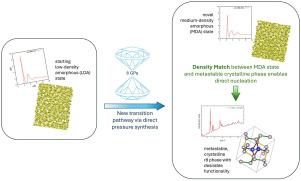Pressure-driven density match nucleates metastable r8 phases from amorphous Si and Ge
IF 22
1区 材料科学
Q1 MATERIALS SCIENCE, MULTIDISCIPLINARY
引用次数: 0
Abstract
The pressure–temperature phase behavior of covalent disordered solids such as amorphous silicon and germanium is complex. Questions remain on possible glass transitions, on polyamorphism via amorphous–amorphous transitions, on connections with liquid–liquid transitions, on structure-behavior relationships, and on their potential as precursor for novel methods for material discovery. Here we demonstrate experimentally the nucleation of a metastable, four-fold coordinated rhombohedral r8 phase from pure amorphous silicon and germanium upon room temperature compression at pressures below 10 GPa. Accompanying theory reveals a strong pressure-driven distortion of the bond angle transforming the starting tetrahedral low-density amorphous network to a distorted four-fold coordinated medium-density state. This state is of lower density than metallic high-density networks, resembles the crystalline r8 phase and initiates its nucleation. Our finding shows that polyamorphism is not the only possible transformation mode for these amorphous solids and that instead nucleation of interesting functional phases at potentially useful pressures is possible. Such novel access modes to metastable structures are critical for future exploitability and could be useful for other tetrahedral materials including carbon, where the related (bc8) post-diamond phase remains elusive. Our observed density match between an amorphous and a metastable crystalline phase clearly allows for a new phase transition pathway, while corresponding theory demonstrates how carefully validated atomistic simulations can guide prediction, discovery and synthesis of novel material structures.

压力驱动密度匹配从非晶Si和Ge中形成亚稳r8相
非晶硅和锗等共价无序固体的压力-温度相行为是复杂的。问题仍然存在于可能的玻璃化转变,通过非晶-非晶转变的多晶化,与液-液转变的联系,结构-行为关系,以及它们作为新材料发现方法先驱的潜力。在这里,我们实验证明了在低于10 GPa的室温压力下,纯非晶硅和锗的亚稳、四重配位菱形体r8相的成核。伴随理论揭示了一种强大的压力驱动的键角畸变,使初始四面体低密度非晶网络转变为扭曲的四倍协调中密度状态。这种状态比金属高密度网络密度低,类似于结晶r8相并开始成核。我们的发现表明,多晶化不是这些非晶固体唯一可能的转变模式,相反,在潜在有用的压力下,有趣的功能相的成核是可能的。这种进入亚稳结构的新模式对未来的开发至关重要,也可能对包括碳在内的其他四面体材料有用,其中相关的(bc8)后金刚石相仍然难以捉摸。我们观察到的非晶态和亚稳态晶体相之间的密度匹配清楚地允许新的相变途径,而相应的理论表明,仔细验证的原子模拟如何指导预测,发现和合成新的材料结构。
本文章由计算机程序翻译,如有差异,请以英文原文为准。
求助全文
约1分钟内获得全文
求助全文
来源期刊

Materials Today
工程技术-材料科学:综合
CiteScore
36.30
自引率
1.20%
发文量
237
审稿时长
23 days
期刊介绍:
Materials Today is the leading journal in the Materials Today family, focusing on the latest and most impactful work in the materials science community. With a reputation for excellence in news and reviews, the journal has now expanded its coverage to include original research and aims to be at the forefront of the field.
We welcome comprehensive articles, short communications, and review articles from established leaders in the rapidly evolving fields of materials science and related disciplines. We strive to provide authors with rigorous peer review, fast publication, and maximum exposure for their work. While we only accept the most significant manuscripts, our speedy evaluation process ensures that there are no unnecessary publication delays.
 求助内容:
求助内容: 应助结果提醒方式:
应助结果提醒方式:


